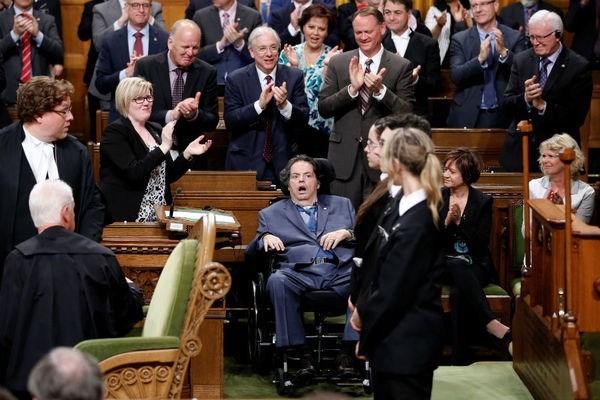
|
| Liberal MP Mauril Bélanger receives a standing ovation yesterday after the approval of his bill to make the national anthem gender neutral - Chris Wattie/Reuters |
Canada is making lyrical changes to its anthem to promote gender equality. Similar changes were rejected just a few years ago. What's changed?
Patriotic love for Canada will no longer be in its "sons command" – at least not exclusively – according to a parliamentary vote.
Lawmakers in the House of Commons agreed yesterday to amend the country's national anthem "O Canada" and replace the gender-specific phrase "in all thy sons command" with "in all of us command" in the English version. Members then stood and sang the anthem in both French and English, Reuters reports.
Speaking to reporters before the vote, Status of Women Minister Patty Hajdu hailed the measure as one that would foster inclusivity.
"I think it's really important as a very strong symbol of our commitment to gender equality in this country," she said.
Gender equality has been a cornerstone of Prime Minister Justin Trudeau's leadership since the Liberal party politician was elected last fall. Mr. Trudeau is the first prime minister to select a cabinet composed of an equal number of men and women, a move that triggered positive international notice after footage of his response to a reporter asking why he did this went viral.
"Because it's 2015," Trudeau quipped in reply at the time.
The measure to change the anthem was introduced by a member of Trudeau's party, MP Mauril Bélanger of Ottawa. The Liberals control the House of Commons, where the bill passed easily. It is expected to pass the next round of approval in the Senate.
While there were some Conservative criticism to the change, that party too had suggested altering the lyrics to make them gender neutral back in 2010. According to CBC News, the proposed change would have actually returned the English lyrics (which are different from the French) to the way they were originally written in the 1908 poem that the anthem is based on: "Thou dost in us command."
Six years ago, the public "overwhelmingly" did not want the change, according to a statement at the time from Dimitri Soudas, the press secretary for Conservative Prime Minister Stephen Harper.
So what's changed?
"The moment has changed," answers Nancy Peckford, executive director of Equal Voice, a multi-partisan organization that advocates for gender equality in Canadian politics. "The culture in and around Canadian Parliament has shifted to allow for this conversation in a more concerted way. There is better awareness and more openness."
Peckford told The Christian Science Monitor that while there is bound to be mixed popular reaction, the "highly symbolic gesture" comes at a time when there is increased public interest in the issue of gender inequality.
Veronica Strong-Boag, former president of the Canadian Historical Association, agrees. She told the Monitor that the proposed changes to the anthem, as well as the popular decision to include more diversity on the national currency, is indicative of a larger rethinking about Canadian national identity. She suggested that the anthem is a way that Canadians view the national self, and taking out gender means "women are now included" in that national self-perception.
"All anthems, like all symbols, are constructed in particular moments," she said. "We need to have due reflection before we rename, but the time has come. In fact it's long overdue."
Historically, Canada has made important political motions in favor of gender equality. It was one of the first nations to sign the UN's Convention on the Elimination of All Forms of Discrimination Against Women, for example, and domestic gender equality has been part of its constitutional charter since 1982.
According to the World Economic Forum's 2015 Global Gender Gap Report, Canada ranked just below the United States and Cuba in gender equality, at number 30 out of 145. The study looks at a handful of markers including health, salary, economic opportunity, education, and political empowerment.
A 2013 study by the Canadian Centre for Policy Alternatives showed glacial progress in equal economic opportunity for Canadian women when it came to political and business leadership roles, however. The report revealed little had changed in the representation of women in these high-ranking positions between 1993 and 2013.
The study noted that this was not due to lack of educational opportunities for women. Instead, higher degrees earned by women correlated to higher levels of wage disparity, according to the report's author, Kate McInturff.
However, with the political shift, and the equal representation of women in the cabinet, Peckford of Equal Voice believes that this will begin to change.
"In the past there wouldn't have been the same level of commitment to or understanding of these issues. Issues that directly effect women have not been a political priority," she said. But, the government's emphasis on gender equality bodes well: "We are optimistic to see what the future looks like."
Permission to use this material
was granted by
Page created on 6/19/2016 2:30:54 AM
Last edited 6/19/2016 2:30:54 AM

